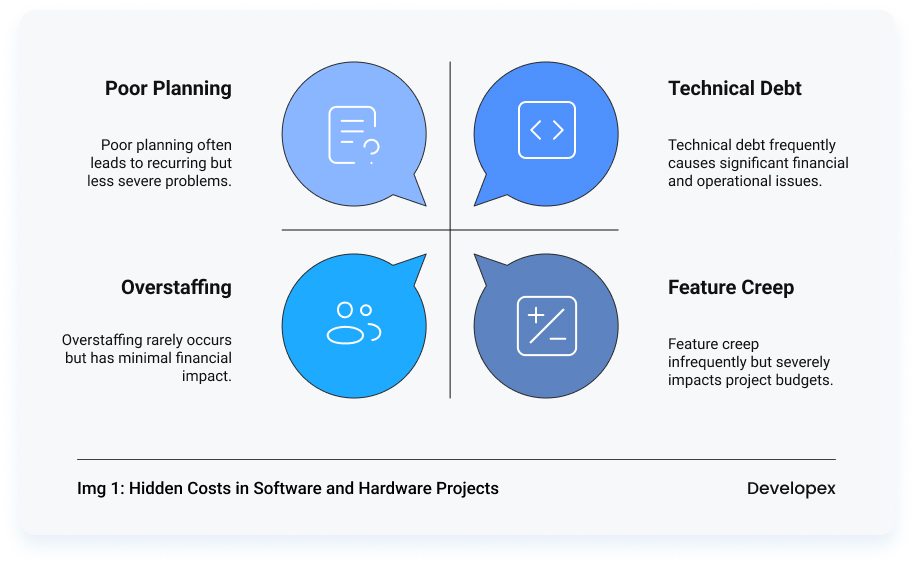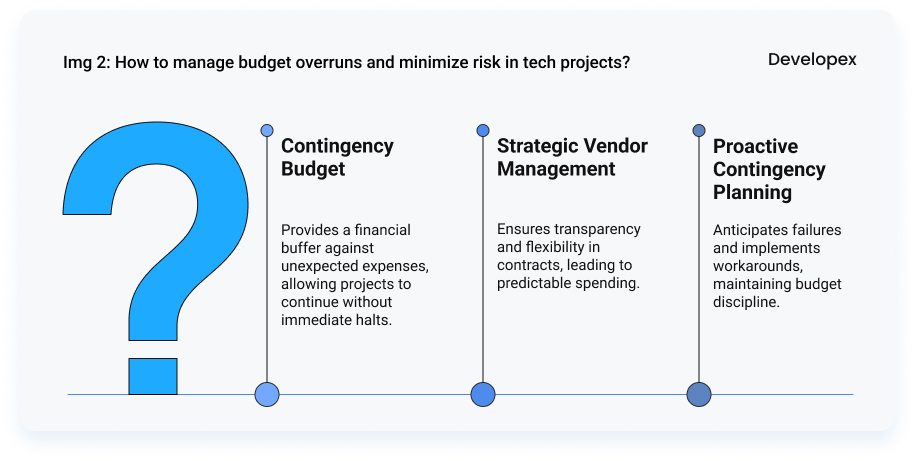
Balancing innovation with tight budgets is one of the top challenges for modern CTOs. Every decision – from choosing the right technology stack to deciding between in-house development or outsourcing – has a direct impact on software and hardware development costs. Missed deadlines, feature creep, and technical debt can quickly inflate budgets, reduce ROI, and slow down product launches.
For CTOs leading complex projects, effective budget planning isn’t just about cutting costs – it’s about making strategic choices that maximize efficiency, prioritize high-impact features, and keep development aligned with business goals.
In this post, we’ll explore proven strategies for development cost optimization, including lean development practices, smart resource allocation, and tools that help monitor expenses. By following these principles, CTOs can confidently control their budgets while still delivering innovative products that meet market demands.
- Understanding the Breakdown of Development Costs
- Hidden Costs That Often Go Unnoticed
- Principles for Smart Budget Optimization
- Proven Strategies to Reduce Development Costs
- Cost Recovery and Risk Mitigation
- Tools & Techniques for Budget Tracking
- Developex Expertise in Cost-Optimized Development
- Final Thoughts
Understanding the Breakdown of Development Costs
Before you can optimize your budget, you must first dissect it. A comprehensive understanding of your spending – both the visible and the hidden – is the bedrock of effective CTO budget planning.
Typical Expenses in Software and Hardware Projects
Development budgets are often dominated by personnel and infrastructure. When analyzing your overall software development costs and hardware development costs, you’re primarily looking at four major categories of expense:
- Engineering Hours: This is the bulk of your spend, covering salaries and contractor fees for frontend, backend, embedded, and firmware engineers. The sheer volume of person-hours required to build a robust product makes this the primary lever for tech project budgeting.
- Business Analysis, Product Ownership, and Project Management – Often underestimated, these roles directly influence cost efficiency. A skilled BA prevents rework by translating vague requirements into precise specifications. A PO maintains product focus, ensuring the team builds the right features, not just more features. And an experienced PM controls delivery pace, mitigates risk, and aligns stakeholders – keeping the entire project financially on track. In practice, this coordination can reduce total development costs by 15–30%, according to PMI’s Pulse of the Profession 2024 Report
- UX/UI and Design: While a smaller percentage of the overall budget, investing in high-quality design is crucial. Poor design decisions early on can lead to costly reworks later in the development cycle.
- QA & Testing: Dedicated quality assurance time, whether manual or automated, is non-negotiable for shipping a stable product. Cutting corners here results in expensive post-launch bug fixes and reputational damage.
- Infrastructure, Cloud Services, and Licenses: This includes everything from AWS or Azure bills to third-party API subscriptions and developer tool licenses. These operational costs are recurring and must be forecast accurately.
Hidden Costs That Often Go Unnoticed
The expenses outlined above are usually straightforward to estimate – engineering hours, testing, or licenses all show up clearly in your budget.
But the greatest financial risk in software and hardware projects often lies in the shadows — the hidden costs that emerge late in development or quietly compound over time. These invisible factors can erode profit margins, stretch delivery timelines, and undermine even the best project plans.

1. Poor Planning and Missing Requirements
Failing to dedicate sufficient time and resources to the initial Discovery and Planning phase is a direct driver of later-stage cost overruns. Rushing into development with incomplete specifications, ambiguous UX/UI flows, or unverified technical architecture guarantees expensive rework down the line. The lack of a comprehensive Product Requirements Document PRD is a primary culprit.
How it affects your bottom line:
- Rework: Developers build features based on assumptions, only to have them rejected or require major changes later.
- Wasted Effort: Entire features are discarded because they don’t integrate with the final system design.
- Time Delays: Teams spend weeks clarifying requirements that should have been finalized during planning.
Solution:
Mandate a structured planning phase with dedicated time for requirements gathering, architecture proof-of-concepts, and UX/UI validation. The PRD must serve as the single source of truth for the scope. Treat the planning phase investment as risk mitigation, not a cost to be cut.
2. Feature Creep
Feature creep is the insidious, uncontrolled expansion of a project’s scope after it has begun. When stakeholder requests constantly shift the goalposts, the initial budget quickly becomes irrelevant.
According to research, nearly 52% of projects experience scope creep, often leading to cost increases beyond original estimates.
How it affects your bottom line:
- Each “small” feature request compounds over multiple sprints.
- QA and regression testing loads grow disproportionately.
- Release schedules stretch, increasing infrastructure and management costs.
Solution:
Mastering controlling feature creep requires disciplined backlog management, a clear change approval process, and strict alignment with product priorities. A well-defined MVP and firm stakeholder communication are the CTO’s first line of defense.
3. Technical Debt
The shortcuts taken today to save time are the interest payments of tomorrow. Unaddressed code inefficiencies, outdated dependencies, and inconsistent architecture all slow down future releases and inflate maintenance costs.
This category also includes the massive expense of the hidden cost of firmware bugs . In hardware-integrated products, each undetected firmware bug that reaches production can trigger expensive hardware recalls, prolonged post-release QA cycles, or devastating brand reputation damage. Industry data shows fixing a firmware bug post-release costs 10–30x more than addressing it during early testing stages.
How it Affects Your Bottom Line:
- Slower development velocity and a higher volume of bugs over time.
- Rising maintenance and refactoring costs.
- Higher onboarding complexity for new developers, delaying their time to full productivity.
- Catastrophic downstream costs from deployed errors (e.g., recalls).
Solution:
Adopt an ongoing software audit process to identify outdated libraries, performance bottlenecks, and security vulnerabilities. Regular refactoring cycles and measurable debt metrics (like code churn and complexity scores) should be built into every roadmap to ensure the debt is constantly serviced.
For embedded systems, this includes investing in robust embedded QA and early-stage hardware-software co-simulation.
4. Overstaffing or Underutilized Resources
Even highly skilled teams can drain budgets if mismanaged. Having top-paid engineers idle between sprints or assigning junior developers to tasks that require excessive supervision leads to inefficient resource allocation and wasted capital.
How it affects your bottom line:
- Unbalanced workloads cause idle time and burnout cycles.
- Excess staffing inflates fixed costs during slower development phases.
- Skill mismatches increase review cycles and delay deliverables.
Solution:
Implement dynamic workforce planning and time tracking across projects. Leverage staff augmentation or cross-functional teams to maintain flexibility. Align engineering capacity tightly with roadmap velocity and priority shifts to minimize unnecessary engineering hours.
Principles for Smart Budget Optimization
True development cost optimization is not about arbitrary cuts; it’s about making smarter, more strategic spending decisions. As CTO, your primary focus should be establishing principles that govern how and where capital is deployed across your technology roadmap.
Aligning Strategy and Spend
The first principle of smart CTO budget planning is ensuring that every dollar spent directly supports the highest-priority business outcomes. Your tech budget is not a cost center; it is an investment vehicle. Therefore, you must rigorously align the budget with product priorities and business goals. This requires continuous consultation with the CEO and Product Managers to define the critical path.
By focusing resources – both financial and human – on features that drive immediate revenue or competitive advantage, you ensure efficient resource allocation in product development and maximize your ROI.
Data-Driven Flexibility
In the agile world, change is constant. A rigid budget is a broken budget. Effective optimization means using data to inform resource allocation in real-time. Use data-driven decision-making (such as feature usage metrics, development velocity, and burn-down rates) to assess if a feature is worth the engineering hours required. This allows you to maintain flexibility to pivot without overspending.
If a feature’s projected ROI drops, you must have the discipline to freeze its development, immediately minimizing unnecessary engineering hours and reallocating those funds to a more promising initiative. This agility is key to preventing budget overruns.
Strategic Sourcing for Talent
A critical principle for cost-effective scaling is the strategic balance of talent sourcing. You must thoughtfully balance in-house teams with outsourcing or staff augmentation. Relying solely on expensive, full-time local hires can make rapid scaling prohibitively costly. Instead, consider:
- Outsourcing Software Development: For self-contained projects, non-core features, or legacy maintenance, working with a specialized third-party vendor can offer immediate cost savings and access to niche skills without the long-term overhead of permanent staff.
- Staff Augmentation for Tech Projects: When you need to temporarily boost the capacity of your existing in-house team with specific expertise (e.g., a short-term cloud architect or a specialized QA engineer), staff augmentation provides flexible, temporary scaling.
This dual approach ensures you have the right mix of stable, culture-driven core competence and flexible, cost-effective capacity.
Proven Strategies to Reduce Development Costs
Moving from abstract principles to concrete action requires implementing strategic shifts in how your teams build, manage, and scale projects. These strategies to optimize software and hardware budgets are the practical steps every CTO should adopt to realize significant savings.
Adopt a Lean Development Approach
The single most effective way to limit unnecessary spend is to embrace lean software development. This methodology mandates ruthless prioritization. You must build MVPs first and prioritize high-ROI features. Instead of trying to perfect a product before launch, define the smallest set of features that delivers maximum value. Every feature not in the MVP is a cost you delay. By focusing your spend exclusively on what moves the needle, you avoid sinking capital into features that users may never adopt.
Leverage Outsourcing and Staff Augmentation
Strategic talent sourcing is one of the most immediate cost-saving strategies in software development. Knowing when to utilize external teams is key. Outsourcing software development is ideal for non-core, specialized, or large-scale projects where internal capacity is lacking.
To succeed, focus on partners with proven experience in your tech stack and a shared commitment to quality and budget adherence. Staff augmentation, on the other hand, is a flexible way to fill short-term skill gaps, boosting your team’s velocity without incurring the long-term, high costs of hiring full-time senior developers.
Invest in Automation and DevOps
Leveraging automation is the ultimate long-term cost-saving strategy, provided the project’s scale and complexity warrant the initial investment.
While implementing robust CI/CD pipelines and comprehensive automation requires an upfront cost, it fundamentally changes your long-term cost structure for complex, large-scale, or long-lived projects.
Strategic Context:
- When it’s effective: Automation is most valuable on projects with frequent deployments, high traffic/user volume, and a need for high quality/stability.
- When to be cautious: On small, simple, or short-term projects, the setup cost may outweigh the savings.
Benefits:
Automation reduces the need for manual intervention across deployment and testing, which in turn leads to lower failure rates and faster cycles. Specifically, automated testing drastically lowers overall QA costs and frees up highly paid engineers from tedious, repetitive tasks, making automation to save development costs a core component of your strategy.
Smart Integration of AI Tools
The smart, targeted use of Generative AI is a nascent but powerful strategy for immediate development cost reduction. AI-powered assistants (like GitHub Copilot or equivalent internal tools) can dramatically increase developer output. By integrating these tools:
- Accelerate Coding: Developers spend less time on boilerplate code, documentation, and routine tasks.
- Reduce Review Cycles: AI can assist with basic code review, identifying errors and suggesting best practices early in the development lifecycle.
Focus your AI investment on areas that boost the efficiency of your most expensive resources: senior engineers.
Use Open-Source and Cost-Effective Tools
One immediate way to curb operational expenses is to review your current tech stack for redundant or overly expensive proprietary software licenses. Always look for reliable open-source alternatives for various tools and libraries used in your software and hardware projects. This doesn’t mean sacrificing capability, but rather choosing mature, community-supported solutions where possible. Making intelligent choices about third-party services and licenses is an often-overlooked area for quick cost-saving strategies.
Continuous Budget Monitoring
Optimization is not a one-time event; it’s a constant discipline. To achieve predictable budgeting for tech teams, you must establish a system of continuous oversight. This means setting up real-time budget dashboards, conducting regular audits of cloud usage and service subscriptions, and maintaining the readiness for resource reallocation.
By actively using tools for monitoring development expenses, you can identify emerging budget overruns or underutilized resources early enough to take corrective action, rather than discovering a problem too late.
Cost Recovery and Risk Mitigation
Even with the most meticulous CTO budget planning, unexpected challenges – from shifting market demands to technical roadblocks – are inevitable. The mark of a financially astute CTO is not avoiding problems entirely, but establishing processes for recovering from budget overruns in tech projects and minimizing risk exposure.

Handling Unexpected Expenses
The first step in cost recovery is accepting that every project requires a contingency budget. This dedicated pool of funds, usually 15−20% of the total project cost, is your financial buffer against the unknown. When an unexpected expense arises, rather than immediately halting development, use the contingency fund while simultaneously initiating a formal project review.
This review must analyze the root cause, identify non-essential scope that can be deferred or cut, and formally reallocate resources. This disciplined approach prevents financial surprises from derailing the entire project timeline.
Strategic Vendor Management
A significant portion of a CTO’s budget often goes to external partners, cloud providers, and software vendors. That’s why choosing the right Agile contract for software development becomes not just a legal decision but a key financial strategy. Contracts define how risk, flexibility, and accountability are distributed across the development lifecycle — and ultimately, how predictable your spending will be.
Never accept standard terms without scrutiny. Instead, focus on transparency and balance:
- Clear Pricing and Terms of Engagement – ensure the payment model (be it Fixed-Price for well-defined, low-risk scopes or Time & Materials (T&M) for agile, evolving projects) is fully transparent. If using T&M, negotiate clear rates, billing increments, and caps to maintain cost control. The goal is predictability, regardless of the pricing model.
- Flexibility without uncertainty – instead of dogmas about “fixed price”, focus on clearly defined stages, acceptance criteria and volume correction mechanisms.
- Measurable conditions – SLAs and contract provisions should contain specific KPIs, not abstract obligations.
- Exit plan – the contract should have clear conditions for the transfer of knowledge and data to avoid vendor lock-in and unforeseen costs during migration.
Proactive Contingency Planning
The most effective risk mitigation strategy is anticipating failures before they happen. Implement contingency planning for delays, dependencies, and scope creep by building these scenarios into your initial budget forecasts. For critical dependencies (e.g., waiting for hardware components or third-party APIs), identify a secondary vendor or an internal workaround plan.
Furthermore, formalizing a rigorous change management process that strictly controls scope creep is non-negotiable. Every requested change must be assessed for its time and cost impact, approved by a budget owner, and result in a mandatory scope/budget adjustment. This ensures you maintain budget discipline in agile teams even when project variables change.
Tools & Techniques for Budget Tracking
Successful development cost optimization requires more than just good intentions; it demands real-time data and robust systems. As a CTO, selecting the right digital toolkit is crucial for turning your principles into actionable, trackable financial discipline.
The core objective of your toolkit should be to provide instant, granular visibility into spend against budget, enabling predictable budgeting for tech teams.
1. Project Management (PM) Tools
These tools serve as the central source of truth for scope, effort, and task assignment. To maximize financial utility, you must integrate time logging and cost variables directly into your workflow management.
Below is an overview of the most effective tools – including the ones most commonly used by Developex in client and internal projects.
| Tool | Key Features | Cost | Best Choice For |
| Atlassian Ecosystem (Jira, Confluence, Bitbucket) | Comprehensive project tracking, documentation, and code repository integration; customizable workflows, agile boards, sprint planning, and extensive reporting capabilities. | Free plan for small teams; Standard from $7.75/user/month; Premium from $15.25/user/month (billed annually). | Development teams of all sizes seeking an integrated ecosystem for agile project management, documentation, and version control with strong developer tooling. |
| Trello | Simple, intuitive Kanban-style boards, easy task visualization, basic automation with Butler, suitable for less complex workflows. | Free plan; Standard from $5/user/month; Premium from $10/user/month (billed annually). | Small teams and straightforward projects requiring simple task management without extensive budget tracking features. |
| Asana | Task and project tracking with timeline views, portfolio management, custom fields for budget tracking, workflow automation. | Free plan for basic use; Premium from $10.99/user/month; Business from $24.99/user/month (billed annually). | Small to mid-size teams managing moderately complex projects with need for visual project planning and basic financial oversight. |
| Wrike | Enterprise-level project and resource planning, AI-powered risk prediction, centralized dashboards, detailed budgeting tools. | Free plan; Paid plans from $10/user/month (billed annually). | Large enterprises requiring robust resource allocation, scheduling, and high scalability. |
| Monday.com | Highly customizable visual dashboards, budgeting widget to track real-time costs vs. estimates, workflow automation. | Free plan; Paid plans from $8/user/month (billed annually). | Mid-size teams and organizations seeking flexibility, visual reporting, and high customizability across different departments. |
| Celoxis | All-in-one Project Portfolio Management (PPM), advanced resource utilization, project cost management (fixed-price, T&M billing), portfolio health reports. | From $10/user/month (annual billing); On-Premise available. | Mid-to-large businesses needing comprehensive Project Portfolio Management with strong financial controls. |
2. Time Tracking & Reporting
Accurate time logs provide the raw data needed to calculate the true cost of features and identify underutilized resources. This is the only way to accurately quantify the cost of engineering hours.
| Tool | Key Features | Cost | Best Choice For |
| Harvest | Seamless time tracking across devices, integrated professional invoicing from tracked time, project budgeting alerts, expense tracking. | Free plan (1 person, 2 projects); Paid plans from $12/seat/month. | Client services businesses (agencies, consultants, freelancers) prioritizing fast, accurate time-to-invoice workflow. |
| Clockify | Simple, free-forever core time tracking for unlimited users, detailed expense tracking, solid reporting; invoicing is an add-on. | Free plan (unlimited users); Paid features from $3.99/user/month. | Small teams, startups, or freelancers needing a powerful, zero-cost starting point for core time tracking and budget management. |
| Productive | Professional Services Automation (PSA), real-time profitability insights, revenue recognition, integrated pipeline forecasting, resource management. | Pricing upon request (typically PSA pricing, high tier); $9/user/month starter cost. | Professional services firms and agencies focused on maximizing utilization and forecasting project profitability. |
3. Cost Forecasting Models
Moving beyond simple spreadsheets, effective software project budgeting tools use data to project future spending, allowing you to proactively adjust resources instead of reacting to overruns.
| Tool | Key Features | Cost | Best Choice For |
| Anaplan | Connected Planning platform, supports complex, multi-dimensional scenario modeling, real-time data integration across all business units (FP&A, HR, Supply Chain). | Pricing upon request (Enterprise-grade). | Large enterprises requiring interconnected, high-complexity planning and advanced financial scenario modeling. |
| Workday Adaptive Planning | Cloud-based solution for financial, operational, and workforce planning, excellent for driver-based planning and multi-entity organizations. | Pricing upon request (Enterprise-grade). | Organizations needing robust, integrated planning that ties financial forecasts directly to workforce and operational drivers. |
| NetSuite ERP (Planning & Budgeting) | Full cloud ERP integration, automates financial processes, collaborative budgeting, and creates accurate, accessible reports from core ERP data. | From $99/user/month (min. seats required); Implementation fees apply. | Businesses that have or are scaling into a comprehensive cloud ERP system and need deeply integrated financial forecasting. |
| Cube Software | Spreadsheet-native FP&A (works directly with Excel/Google Sheets), AI-powered, real-time consolidation, quick scenario modeling. | From $1,500/user/month (for full suite). | Finance teams who prefer working primarily in spreadsheets but require automated, governed data consolidation and forecasting capabilities. |
4. Analytics Dashboards for Cost Management
These tools are the CTO’s financial cockpit, aggregating data from the sources above, plus critical cloud billing data, to provide a consolidated view of your entire spend.
| Tool | Key Features | Cost | Best Choice For |
| Microsoft Power BI | Strong visual analytics, deep integration with the Microsoft ecosystem (Excel, Azure, Dynamics 365), extensive data connectors. | Free desktop version; Pro Plan from $14.00/user/month. | Businesses heavily invested in the Microsoft stack and needing self-service BI and cloud connectivity for financial data analysis. |
| Tableau | Industry leader in data visualization, highly intuitive drag-and-drop interface, handles large and complex datasets easily, strong community support. | Creator license from $70/user/month. | Data analysts and businesses prioritizing deep, beautiful data exploration, visualization, and storytelling. |
| Zoho Analytics | Self-service BI with Agentic AI, wide range of integrations (especially with Zoho Suite), collaborative and mobile-optimized dashboards for quick insights. | Free trial; Paid plans from $25/user/month (billed annually). | Small to mid-size businesses, particularly those using other Zoho products, seeking an affordable, comprehensive BI solution with AI assistance. |
Developex Expertise in Cost-Optimized Development
Implementing a comprehensive development cost optimization strategy requires a partner who understands the complexities of both engineering and finance. At Developex, we don’t just write code; we partner with CTOs and Product Managers to embed budget discipline and efficiency into the core of the development lifecycle.
Our expertise bridges the gap between ambitious product roadmaps and practical, cost-effective execution:
- Full-Cycle Software Development & Integration: We manage the entire development lifecycle, offering integrated teams for embedded systems, desktop applications, cross-platform solutions, QA, and UX/UI. This holistic approach ensures that cost decisions made in design (UX/UI) are aligned with the cost implications in firmware or testing (QA), avoiding the financial misalignment that often plagues multi-vendor projects.
- Managing Complex Hardware & Software Projects: We specialize in tech projects where hardware development costs and software development costs are tightly intertwined. Our proven methodologies help predict and control expenses in environments where dependencies are high, like IoT or specialized industrial applications, ensuring your tech project budgeting is accurate from prototype to final deployment.
- Long-Term Cost Optimization Partnership: We move beyond simple outsourcing software development by providing strategic staff augmentation for tech projects that is specifically designed for budget agility. We embed our business analysts and project managers into your structure to maintain budget discipline in agile teams, helping you constantly monitor expenses and maximize ROI in software projects for sustained financial health. We act as a trusted extension of your leadership, dedicated to helping you optimize development spend without compromising on product quality.
Final Thoughts
Optimizing development costs isn’t about cutting corners; it’s about strategic oversight, clear priorities, and smart processes. From accurately tracking engineering hours to leveraging the expertise of Business Analysts, Product Owners, and Project Managers, every role plays a critical part in preventing waste and hidden costs.
Understanding both visible expenses – like engineering, design, QA, and infrastructure – and hidden costs, such as feature creep, technical debt, and firmware bugs, allows CTOs to make informed decisions that safeguard budgets without compromising quality. Thoughtful adoption of tools, selective automation, and structured vendor management further enhance predictability and efficiency across the development lifecycle.
At Developex, we help CTOs bridge the gap between ambitious product roadmaps and practical execution. Through full-cycle development, strategic staff augmentation, and deep expertise in both software and hardware projects, we ensure development spend is optimized without sacrificing innovation or quality.
Contact us today to discuss how our strategic staff augmentation and development expertise can drive long-term development cost optimization for your product roadmap.






